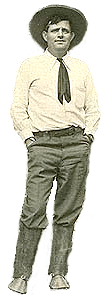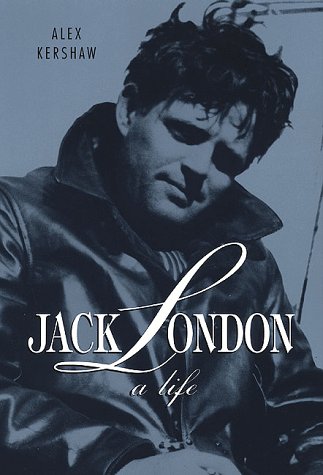|
|
|
|
|
|
 John
Griffith London was born in San Francisco in 1876, the son of Flora Wellman.
He derived his name from his stepfather, having never confirmed the identity
of his biological father. Unfortunately for the young London his
education was unorthodox and "spotty." In order to support his family
he performed many odd jobs often for meager wages. This would help
kindle his socialist beliefs later in life.
John
Griffith London was born in San Francisco in 1876, the son of Flora Wellman.
He derived his name from his stepfather, having never confirmed the identity
of his biological father. Unfortunately for the young London his
education was unorthodox and "spotty." In order to support his family
he performed many odd jobs often for meager wages. This would help
kindle his socialist beliefs later in life.
In 1891, at the age of fifteen, London engaged in oyster piracy after purchasing a boat with borrowed money. The work was highly illegal and risky but also adventurous. In the following year London found himself on the right side of the law as he became a deputy with the State Fish Patrol. Ironically his job included chasing salmon poachers and illegal shrimpers. Later he signed on a sealing schooner and spent five months in the Pacific. This interlude provided rich materials for his later novel The Sea Wolf. In 1894 London fell on more hard times as he joined Kelly's Industrial Army, a group of unemployed men determined to march to Washington and demand workers' rights. London was with this group only for a short time before turning tramp. His life hit a new low when he found himself in the Erie County Penitentiary for vagrancy.
Convinced that he could not succeed without a formal education, London entered high school in 1895. He devoted himself entirely to his studies and in the following year he was granted admittance to the University of California. Unfortunately pressing financial concerns at home forced him to drop out after only one semester. Thus ended the formal period of London's education; from now on he would learn from life experiences.
One of the most inspiring journeys London ever experienced was in March, 1897 during the Klondike gold rush. The last of the great gold rushes had begun in the previous year when a small group of miners discovered gold in the Yukon territory. By the time London traveled north on borrowed money many thousands had already made the journey to the rich gold fields, hoping to strike it rich. Unfortunately most people, London included, returned with empty pockets. However, London had discovered a rich vein of inspiration for dozens of stories. By 1899 London was enjoying success because of his writing. Magazines routinely published his short stories and in 1903 Macmillan and Co. published The Call of the Wild, which has been hailed as one of the great American novels. White Fang, which also had its roots in London's journey to the north, was published in 1906 with critical acclaim.
Throughout his mature years London continued to be a hard worker. Each day he would sit down and write at least a thousand words before attending to his other daily tasks. He drew inspiration from his own life, which was hardly ever dull. Truly London was endowed with a restless spirit. He tried to communicate some of this wanderlust in his multitude of writings. Contrary to popular belief London did not write about the Klondike exclusively, although works based upon his northern adventures are the most widely read. In The Sea Wolf, London drew upon his experiences as a young hand on a sealing schooner patrolling the Pacific and engaging in a brutal trade. Later he traveled to South Africa, Korea and Mexico as a war correspondent and political commentator. In 1907 he made a long journey of the South Pacific in his own vessel, "The Snark." This journey provided rich material for stories and also increased the level of tourism in the Hawaiian Islands.
Unfortunately not every aspect of London's life was successful. Although London was paid exceptionally well for his work, he never could come to grips with sound money management. To worsen the situation London also had to support his aging mother and supply money to his friends. He wasted enormous sums on his yacht and Wolf House, a manor which burned to the ground before London could occupy it. London married twice. Although his marriage to Charmian lasted, London himself was not completely happy. However, they traveled together and had numerous adventures in distant lands. London did not make serious attempts to stay healthy throughout his life. He habitually smoked around sixty filterless cigarettes a day and was a heavy drinker. This lifestyle eventually caught up to him and his health deteriorated in his final years. Jack London died on November 22, 1916 at his ranch near Sonoma, California. He left behind a wondrous legacy of novels, short stories, essays, correspondence, plays, travel books and even an autobiography. The Call of the Wild continues to be a popular novel in America. His lesser known works continue to be popular outside of their native land as they have been translated into numerous languages. Many literary and social critics have come to hail Jack London as one of the most influential Americans of the early twentieth century.
- I derived some of the information for this biography
from Dwight Swain's introduction to the Aerie Books Ltd. edition of The
Call of the Wild, copyright 1986.
Jack London and "Jack London's
Call
of the Wild"
(The Novel vs. the Television Series)
For those people who have read the novel The Call of the Wild and have watched at least some of the series, noticeable differences between the written work and dramatic series are apparent. Although I have always supported the show and the world it recreates, I have heard some criticism that deserves to be addressed. Why name the series "Jack London's Call of the Wild" when it is so different from the novel? Indeed there are numerous differences, not least of which is the incorporation of characters London never wrote about. Certain characters and aspects of the story line do remain loyal to the original novel. Firstly, John Thornton is a principal character in the novel as he is in the series. Secondly, Buck is stolen from San Francisco and is brought up to the Yukon to serve as a sled dog. This much is also made clear in the series, yet we do not witness the same progression of Buck's owners as we do in the novel. Buck is subjected to a test of strength and succeeds in both novel and series. In both venues Buck is also involved in pulling the sleigh for two naive prospectors, Hal and Mercedes Levant. Despite these similarities there are numerous differences that seem to merit the renaming of the series. But we must ask ourselves, what was the motivating factor behind the series in the first place?
The series attempts to recreate the
harsh, adventurous world of the Klondike gold rush. What author captured
the stark beauty and brutality of this era better than Jack London?
The series attempts to tap into this same spirit of adventure that London
experienced firsthand and captured in his writing. The series does
not seriously endeavor to completely recreate the story of the novel.
Simply put, that would make for a rather poor series. Much of the
turmoil and driving force of the novel is internally experienced by the
main character, a dog. Although it is possible to portray such an
internal experience in a movie, though in a limited fashion (Benji,
the Hunted comes to mind), it becomes impossible to stretch this
experience into a dramatic series. Buck's development and characterization
in the series can only come about through his interaction with people,
places and events. A great deal of Buck's contact with humanity in
the novel is brief and often violent. Moreover, his development and
the lure of the wolves is something he internally experiences. And
although this experience certainly makes for an introspective novel which
provides valuable reading, the same internal experience is inappropriate
for a dramatic television series that attempts to recreate a bygone era.
The name Jack London still evokes a sense of adventure and conjures images
of the gold rush. Although this use of "Jack London" only taps into
the popular notion of Jack London's work, it signifies adventure.
On this page I have only provided a
very short overview of London's complex and adventurous life. Although
I designed the site to provide information regarding the television series,
certainly some mention of the author behind it all is appropriate.
For those readers who are interested in finding out more about this provocative
author and his works, I suggest the following two sources:
 Firstly, I suggest Alex Kershaw's recent biography, Jack London: A Life,
copyright 1999 and published by Griffin Trade Paperback (ISBN: 0312199904X).
I purchased this book this past winter (2001 - 02) and it quickly grabbed
my interest. Kershaw writes well and provides many details concerning
London's life and times. Although he does provide some plot summary
for a few of the novels, he never indulges in scholarly analysis or literary
critique. He tends to stick to the facts and attempts to view the
author's life as objectively as possible. At 368 pages it is a fair
but not overly long read and the chapters are well divided. The book
also includes photographs of London and some of the exotic locations he
visited throughout his life.
Firstly, I suggest Alex Kershaw's recent biography, Jack London: A Life,
copyright 1999 and published by Griffin Trade Paperback (ISBN: 0312199904X).
I purchased this book this past winter (2001 - 02) and it quickly grabbed
my interest. Kershaw writes well and provides many details concerning
London's life and times. Although he does provide some plot summary
for a few of the novels, he never indulges in scholarly analysis or literary
critique. He tends to stick to the facts and attempts to view the
author's life as objectively as possible. At 368 pages it is a fair
but not overly long read and the chapters are well divided. The book
also includes photographs of London and some of the exotic locations he
visited throughout his life.
 Secondly, I suggest the best online resource I have discovered pertaining
to all aspects of Jack London's life and works, The Jack London Collection
(http://sunsite.berkeley.edu/London/).
The site derives its contents from the University of California, Berkeley
which holds a great deal of resources pertaining to Jack London.
On this site you will discover numerous photographs of the author and his
friends. Furthermore you can view original letters written by the
author to various correspondents. The site also contains the full
text version of many of his works, including several novels. This
is by far the most complete online source I have found. I highly
recommend beginning at this site.
Secondly, I suggest the best online resource I have discovered pertaining
to all aspects of Jack London's life and works, The Jack London Collection
(http://sunsite.berkeley.edu/London/).
The site derives its contents from the University of California, Berkeley
which holds a great deal of resources pertaining to Jack London.
On this site you will discover numerous photographs of the author and his
friends. Furthermore you can view original letters written by the
author to various correspondents. The site also contains the full
text version of many of his works, including several novels. This
is by far the most complete online source I have found. I highly
recommend beginning at this site.